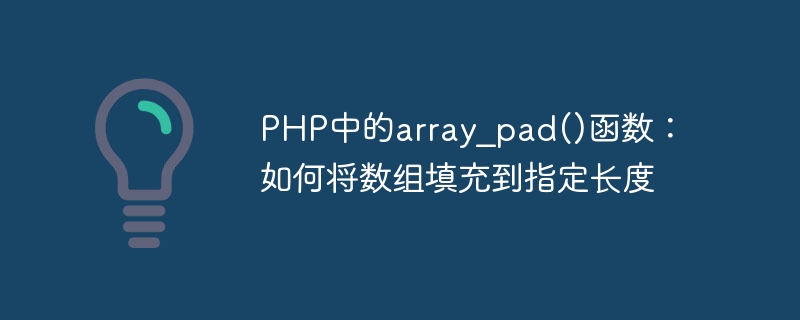Home >Backend Development >PHP Tutorial >array_pad() function in PHP: how to pad an array to a specified length
array_pad() function in PHP: how to pad an array to a specified length
- PHPzOriginal
- 2023-11-03 10:09:451623browse

array_pad() function in PHP: How to fill an array to a specified length, specific code examples are needed
In PHP development, it is often encountered that the array needs to be Padding to a specified length. At this time, you can use PHP's built-in array_pad() function to implement this function. This article will introduce the usage of array_pad() function and give specific code examples.
The array_pad() function is a very practical function. It can extend the array to the specified length and fill the empty spaces in the array with the specified value. Its syntax format is as follows:
array array_pad ( array $array , int $size , mixed $value )
Parameter description:
$array: the array that needs to be filled.
$size: Specify the length that the array needs to reach.
$value: The filled value, which can be a string, number, array, etc.
Below, we illustrate the usage of array_pad() function through several specific code examples:
Example 1:
<?php $array = ['apple', 'banana', 'cherry']; $newArray = array_pad($array, 5, 'orange'); print_r($newArray); ?>
Output result:
Array
(
[0] => apple
[1] => banana
[2] => cherry
[3] => orange
[4] => orange
)In the above example, there are 3 elements in the original array $array, we use the array_pad() function to fill it to length 5 and fill it with the value 'orange'. The final new array $newArray has 5 elements, the original 3 elements remain unchanged, and the last 2 elements of the array are filled with 'orange'.
Example 2:
<?php $array = ['apple', 'banana', 'cherry']; $newArray = array_pad($array, 8, ['kiwi', 'mango']); print_r($newArray); ?>
Output result:
Array
(
[0] => apple
[1] => banana
[2] => cherry
[3] => Array
(
[0] => kiwi
[1] => mango
)
[4] => Array
(
[0] => kiwi
[1] => mango
)
[5] => Array
(
[0] => kiwi
[1] => mango
)
[6] => Array
(
[0] => kiwi
[1] => mango
)
[7] => Array
(
[0] => kiwi
[1] => mango
)
)In the above example, we use the array_pad() function to fill the original array $array to a length of 8, and use The array ['kiwi', 'mango'] is filled. The first 3 elements of the new array $newArray remain unchanged from the original array, and then the next 5 elements are filled with the array ['kiwi', 'mango'].
Through the above two examples, we can see that the usage of the array_pad() function is very simple. Just give the original array, target length and padding value, and the function can automatically fill the original array to the specified length.
It should be noted that if the target length is smaller than the length of the original array, the array_pad() function will not make any modifications to the original array, but will return the original array as is. This feature is also very practical in certain scenarios.
Summary: The array_pad() function is a very practical array filling function in PHP. It can easily extend the array to the specified length and fill it with the specified value. During development, we often encounter situations where we need to adjust the length of an array. In this case, we can flexibly use the array_pad() function to meet our needs.
We hope that the introduction and sample code of this article can help PHP developers better understand and apply the array_pad() function and improve development efficiency.
The above is the detailed content of array_pad() function in PHP: how to pad an array to a specified length. For more information, please follow other related articles on the PHP Chinese website!

